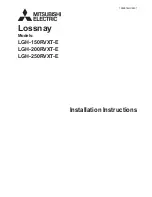
14
Fire Ready Hood
Inline/Wall Mount Fan Power (if applicable)
Twenty-five (25) feet of plenum rated wire is provided
with both the inline fan and wall mounted fan option.
The fan needs to be connected with the provided
connector within the hood controls. See wiring diagram
on page 15 for wiring information.
ClockBox (if applicable)
Twenty (20) feet of shielded control wire is provided with
the ClockBox option to connect the ClockBox controller
to the touchscreen interface. The ClockBox needs to be
connected back via the connector within hood controls.
See wiring diagram on page 15 for wiring information.
Remote ADA Switches (if applicable)
Eight (8) feet of shielded control wire is provided with
the ADA remote switch option. The switches need to be
connected back with the provided connector within the
hood controls. See wiring diagram on page 15 for wiring
information.
Fire Alarm System Connections
The hood unit has two fire alarm connections (discrete
switches), each with its own trigger. A connection is
made to one output (Y#) and one common (C#) at the
controller. The output labeled Y0 is triggered by a fault
from the high temperature switch (190°F), or pressure
switch, or hose switch. Output Y1 is triggered by a
high temperature switch (190°F)
and
a low pressure
fault in the extinguisher tank (the fire suppressant has
discharged). You may use either one connection or
both, depending on your situation. When there is a fault,
a buzzer in the unit will sound and the power disconnect
will turn off.
Local Alarm Connection:
Connect to output Y0 and
common C0
Remote Alarm Connection:
Connect to output Y1 and
common C1
To connect to the alarms, it is preferred that you use a
spade terminal connector (supplied), but a stripped wire
is acceptable.
Connecting the alarm system in the configuration
described above results in a normally open connection.
To switch these two alarm contacts to normally closed
connections, insert a jumper into the blue and the gray
terminal adjacent to it
(terminal blocks 4 and 5)
. One
leg of the provided jumper is inserted into the blue
terminal and the other into the gray terminal.
In addition to the fire alarm system connections
described previously, a second connection may be
made to the fire alarm switch installed in the unit. Unlike
the connection above, this switch does not require
power to be fed to the hood in order to function. The
fire alarm switch is located above the actuator arm,
beside the controller assembly. The fire alarm switch is
activated when the actuator arm trips.
To connect the fire alarm switch, wire the fire alarm to
the common connector and normally open or normally
closed connection as shown.
NOTE
Ensure jumper is inserted completely and the top of
the jumper is level with the other jumpers.
Y0
Y1
C0
C1
Onboard Controller
Common
Normally Open
Normally Closed
Fire Alarm Switch














































